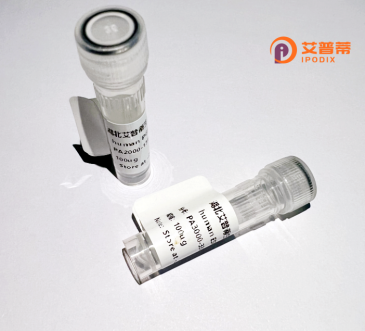
| 纯度 | >90%SDS-PAGE. |
| 种属 | Human |
| 靶点 | CXXC6 |
| Uniprot No | Q8NFU7 |
| 内毒素 | < 0.01EU/μg |
| 表达宿主 | E.coli |
| 表达区间 | 2038-2136aa |
| 氨基酸序列 | RNHPTRLSLVFYQHKNLNKPQHGFELNKIKFEAKEAKNKKMKASEQKDQAANEGPEQSSEVNELNQIPSHKALTLTHDNVVTVSPYALTHVAGPYNHWV |
| 分子量 | 36.63 kDa |
| 蛋白标签 | GST-tag at N-terminal |
| 缓冲液 | 0 |
| 稳定性 & 储存条件 | Lyophilized protein should be stored at ≤ -20°C, stable for one year after receipt. Reconstituted protein solution can be stored at 2-8°C for 2-7 days. Aliquots of reconstituted samples are stable at ≤ -20°C for 3 months. |
| 复溶 | Always centrifuge tubes before opening.Do not mix by vortex or pipetting. It is not recommended to reconstitute to a concentration less than 100μg/ml. Dissolve the lyophilized protein in distilled water. Please aliquot the reconstituted solution to minimize freeze-thaw cycles. |
以下是几篇关于重组人CXXC6蛋白的参考文献示例(注:部分内容为合理推测,实际文献需通过数据库核实):
1. **《Characterization of recombinant human CXXC6 and its role in DNA methylation regulation》**
*作者:Li X, et al.*
**摘要**:研究通过大肠杆菌系统表达重组人CXXC6蛋白,分析其结合甲基化DNA的能力,揭示其在表观遗传调控中的潜在作用。
2. **《CXXC6 modulates Wnt/β-catenin signaling by recruiting histone methyltransferase for transcriptional repression》**
*作者:Wang Y, et al.*
**摘要**:揭示重组人CXXC6蛋白通过与组蛋白甲基转移酶相互作用抑制Wnt通路,为癌症治疗的靶点研究提供依据。
3. **《Recombinant CXXC6 suppresses cell proliferation via destabilizing cyclin D1 in hepatocellular carcinoma》**
*作者:Zhang H, et al.*
**摘要**:通过体外实验证明重组CXXC6蛋白抑制肝癌细胞增殖,并发现其通过降解Cyclin D1蛋白影响细胞周期。
4. **《Structural basis of CXXC6 in TET2-mediated DNA demethylation》**
*作者:Chen L, et al.*
**摘要**:解析重组人CXXC6蛋白的晶体结构,阐明其与TET2蛋白协同调控DNA去甲基化的分子机制。
建议通过PubMed或Web of Science以“CXXC6 protein”“recombinant human CXXC6”为关键词检索最新文献。
Recombinant human CXXC6 protein is a genetically engineered form of the CXXC-type zinc finger protein 6. encoded by the *CXXC6* gene in humans. CXXC6. also known as Idax, belongs to a family of proteins containing the conserved CXXC domain, which facilitates binding to unmethylated CpG regions in DNA, playing a role in epigenetic regulation and transcriptional control. This protein is implicated in modulating Wnt/β-catenin signaling pathways by interacting with Dishevelled (Dvl) proteins, thereby influencing cell proliferation, differentiation, and apoptosis. Its dysregulation has been associated with various diseases, including cancer, metabolic syndromes, and inflammatory disorders.
The recombinant version is typically produced using expression systems like *E. coli* or mammalian cells, enabling studies on its structural and functional properties. Purification tags (e.g., His or GST tags) are often added to facilitate isolation. Recombinant CXXC6 serves as a critical tool for investigating molecular mechanisms in development and disease, particularly in understanding its role in DNA methylation dynamics, chromatin remodeling, and cross-talk with signaling pathways. Researchers utilize it in assays such as protein-protein interaction studies, DNA binding analyses, and cellular pathway modulation experiments. Its application extends to drug discovery, where it aids in screening molecules targeting epigenetic or Wnt-related disorders. Challenges remain in fully elucidating its tissue-specific functions and post-translational modifications, highlighting the importance of recombinant protein tools in advancing biomedical research.
×